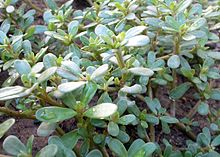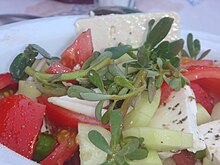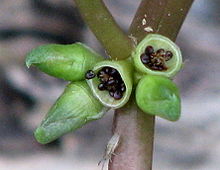Portulaca oleracea
| Portulaca oleracea | |
|---|---|

| |
| Scientific classification | |
| Kingdom: | |
| (unranked): | |
| (unranked): | |
| (unranked): | |
| Order: | |
| Family: | |
| Genus: | |
| Species: | P. oleracea
|
| Binomial name | |
| Portulaca oleracea | |
| Synonyms | |
|
Portulacaria oleracea | |

Portulaca oleracea (common purslane, also known as verdolaga, pigweed, little hogweed, or pursley, and moss rose) is an annual succulent in the family Portulacaceae, which may reach 40 cm in height.
| Nutritional value per 100 g (3.5 oz) | |||||||||||||||||||||||||||||||||||||||||||
|---|---|---|---|---|---|---|---|---|---|---|---|---|---|---|---|---|---|---|---|---|---|---|---|---|---|---|---|---|---|---|---|---|---|---|---|---|---|---|---|---|---|---|---|
| Energy | 84 kJ (20 kcal) | ||||||||||||||||||||||||||||||||||||||||||
3.39 g | |||||||||||||||||||||||||||||||||||||||||||
0.36 g | |||||||||||||||||||||||||||||||||||||||||||
2.03 g | |||||||||||||||||||||||||||||||||||||||||||
| |||||||||||||||||||||||||||||||||||||||||||
| Other constituents | Quantity | ||||||||||||||||||||||||||||||||||||||||||
| Water | 92.86 g | ||||||||||||||||||||||||||||||||||||||||||
| †Percentages estimated using US recommendations for adults,[1] except for potassium, which is estimated based on expert recommendation from the National Academies.[2] | |||||||||||||||||||||||||||||||||||||||||||
Approximately forty varieties currently are cultivated.[3] It has an extensive Old World distribution extending from North Africa through the Middle East and the Indian Subcontinent to Malesia and Australasia. The species status in the New World is uncertain: in general, it is considered an exotic weed, however, there is evidence that the species was in Crawford Lake deposits (Ontario) in 1430-89 AD, suggesting that it reached North America in the pre-Columbian era.[4] It is naturalised elsewhere and in some regions is considered an invasive weed. It has smooth, reddish, mostly prostrate stems and alternate leaves clustered at stem joints and ends. The yellow flowers have five regular parts and are up to 6 mm wide. Depending upon rainfall, the flowers appear at anytime during the year. The flowers open singly at the center of the leaf cluster for only a few hours on sunny mornings. Seeds are formed in a tiny pod, which opens when the seeds are mature. Purslane has a taproot with fibrous secondary roots and is able to tolerate poor, compacted soils and drought.
Uses
Culinary usage

Although purslane is considered a weed in the United States, it may be eaten as a leaf vegetable. It has a slightly sour and salty taste and is eaten throughout much of Europe, the middle east, Asia, and Mexico.[3][5] The stems, leaves and flower buds are all edible. Purslane may be used fresh as a salad, stir-fried, or cooked as spinach is, and because of its mucilaginous quality it also is suitable for soups and stews. Australian Aborigines use the seeds to make seedcakes. Greeks, who call it andrakla (αντράκλα) or glystrida (γλυστρίδα), use the leaves and the stems with feta cheese, tomato, onion, garlic, oregano, and olive oil, add it in salads, boil it or add to casseroled chicken. In Turkey, besides being used in salads and in baked pastries, it is cooked as a vegetable similar to spinach. In Albania it is called burdullak, and also is used as a vegetable similar to spinach, mostly simmered and served in olive oil dressing, or mixed with other ingredients as a filling for dough layers of byrek. In the south of Portugal (Alentejo), "baldroegas" are used as a soup ingredient.
Nutrition
Purslane contains more omega-3 fatty acids (alpha-linolenic acid in particular[6]) than any other leafy vegetable plant. Studies have found that Purslane has 0.01 mg/g of eicosapentaenoic acid (EPA). This is an extraordinary amount of EPA for a land-based vegetable source. EPA is an Omega-3 fatty acid found mostly in fish, some algae, and flax seeds.[7] It also contains vitamins (mainly vitamin A, vitamin C, Vitamin E (alpha-tocopherol)[8] and some vitamin B and carotenoids), as well as dietary minerals, such as magnesium, calcium, potassium, and iron. Also present are two types of betalain alkaloid pigments, the reddish betacyanins (visible in the colouration of the stems) and the yellow betaxanthins (noticeable in the flowers and in the slight yellowish cast of the leaves). Both of these pigment types are potent antioxidants and have been found to have antimutagenic properties in laboratory studies.[9]
100 Grams of fresh purslane leaves (about half a cup) contain 300 to 400 mg of alpha-linolenic acid.[10] One cup (250 ml) of cooked leaves contains 90 mg of calcium, 561 mg of potassium, and more than 2,000 IUs of vitamin A. A half-cup of purslane leaves contains as much as 910 mg of oxalate, a compound implicated in the formation of kidney stones; however, many common vegetables, such as spinach, also can contain high concentrations of oxalates. Cooking purslane reduces overall soluble oxalate content by 27%, which is important considering its suggested nutritional benefits of being part of a healthy diet.[11]
When stressed by low availability of water, purslane, which has evolved in hot and dry environments, switches to photosynthesis using Crassulacean acid metabolism (the CAM pathway): At night its leaves trap carbon dioxide, which is converted into malic acid (the souring principle of apples), and, in the day, the malic acid is converted into glucose. When harvested in the early morning, the leaves have ten times the malic acid content as when harvested in the late afternoon, and thus have a significantly more tangy taste.
Traditional medicine


Known as Ma Chi Xian (pinyin: translates as "horse tooth amaranth") in traditional Chinese medicine, its active constituents include: noradrenaline, calcium salts, dopamine, DOPA[disambiguation needed], malic acid, citric acid, glutamic acid, asparagic acid, nicotinic acid, alanine, glucose, fructose, and sucrose.[12] Betacyanins isolated from Portulaca oleracea improved cognition deficits in aged mice.[13] A rare subclass of Homoisoflavonoids, from the plant, showed in vitro cytotoxic activities towards four human cancer cell lines.[14] Use is contraindicated during pregnancy and for those with cold and weak digestion.[12] Purslane is a clinically effective treatment for oral lichen planus,[15] and its leaves are used to treat insect or snake bites on the skin,[16] boils, sores, pain from bee stings, bacillary dysentery, diarrhea, hemorrhoids, postpartum bleeding, and intestinal bleeding.[12]
Portulaca oleracea efficiently removes bisphenol A, an endocrine-disrupting chemical, from a hydroponic solution. How this happens is unclear.[17]
Companion plant
As a companion plant, Purslane provides ground cover to create a humid microclimate for nearby plants, stabilising ground moisture. Its deep roots bring up moisture and nutrients that those plants can use, and some, including corn, will "follow" purslane roots down through harder soil that they cannot penetrate on their own (ecological facilitation). It is known as a beneficial weed in places that do not already grow it as a crop in its own right.
History
Widely used in East Mediterranean countries, archaeobotanical finds are common at many prehistoric sites. In historic contexts, seeds have been retrieved from a protogeometric layer in Kastanas, as well as from the Samian Heraion dating to seventh century B.C. In the fourth century B.C., Theophrastus names purslane, andrákhne (ἀνδράχνη), as one of the several summer pot herbs that must be sown in April (H.P 7.12).[18] As portulaca it figures in the long list of comestibles enjoyed by the Milanese given by Bonvesin de la Riva in his "Marvels of Milan" (1288).[19]
In antiquity, its healing properties were thought so reliable that Pliny the Elder advised wearing the plant as an amulet to expel all evil (Natural History 20.120).[18]
A common plant in parts of India, purslane is known as Sanhti, Punarva, or Kulfa.
Popular culture
- The name verdolaga, associated with the plant that grows in South America is a nickname for Football clubs with green-white schemes in their uniforms, such as Colombia's Atletico Nacional and Argentina's Ferrocarril Oeste.
See also
References
- ^ United States Food and Drug Administration (2024). "Daily Value on the Nutrition and Supplement Facts Labels". FDA. Archived from the original on 2024-03-27. Retrieved 2024-03-28.
- ^ National Academies of Sciences, Engineering, and Medicine; Health and Medicine Division; Food and Nutrition Board; Committee to Review the Dietary Reference Intakes for Sodium and Potassium (2019). Oria, Maria; Harrison, Meghan; Stallings, Virginia A. (eds.). Dietary Reference Intakes for Sodium and Potassium. The National Academies Collection: Reports funded by National Institutes of Health. Washington, DC: National Academies Press (US). ISBN 978-0-309-48834-1. PMID 30844154. Archived from the original on 2024-05-09. Retrieved 2024-06-21.
- ^ a b Marlena Spieler (July 5, 2006). "Something Tasty? Just Look Down". The New York Times.
- ^ Byrne, R. and McAndrews, J. H. (1975). "Pre-Columbian puslane (Portulaca oleracea L.) in the New World". Nature. 253 (5494): 726–727. doi:10.1038/253726a0.
{{cite journal}}: CS1 maint: multiple names: authors list (link) - ^ Pests in Landscapes and Gardens: Common Purslane. Pest Notes University of California Agriculture and Natural Resources Publication 7461. October 2003
- ^ David Beaulieu. "Edible Landscaping With Purslane". About.com.
- ^ ARTEMIS P SIMOPOULOS Omega-3 Fatty Acids and Antioxidants in Edible Wild Plants. 2004. Biol Res 37: 263-277, 2004
- ^ Simopoulos AP, Norman HA, Gillaspy JE, Duke JA. Common purslane: a source of omega-3 fatty acids and antioxidants. J Am Coll Nutr. 1992;11(4):374-82.
- ^ Evaluation of the Antimutagenic Activity of Different Vegetable Extracts Using an In Vitro Screening Test
- ^ A. P. Simopoulos, H. A. Norman, J. E. Gillaspy, and J. A. Duke. Common purslane: a source of omega-3 fatty acids and antioxidants. Journal of the American College of Nutrition, Vol 11, Issue 4 374-382, Copyright © 1992
- ^ http://world-food.net/oxalate-content-of-raw-and-cooked-purslane/
- ^ a b c Tierra, C.A., N.D., Michael (1988). Planetary Herbology. Lotus Press. p. 199.
{{cite book}}: CS1 maint: multiple names: authors list (link) - ^ Wang CQ. Yang GQ., "Betacyanins from Portulaca oleracea L. ameliorate cognition deficits and attenuate oxidative damage induced by D-galactose in the brains of senescent mice.,Phytomedicine. 17(7):527-32, 2010 Jun.
- ^ Yan J, Sun LR, Zhou ZY, Chen YC, Zhang WM, Dai HF, Tan JW "Homoisoflavonoids from the medicinal plant Portulaca oleracea." Phytochemistry. 2012 Aug;80:37-41
- ^ Agha-Hosseini F, Borhan-Mojabi K, Monsef-Esfahani HR, Mirzaii-Dizgah I, Etemad-Moghadam S, Karagah A (Feb 2010). "Efficacy of purslane in the treatment of oral lichen planus". Phytother Res. 24 (2): 240–4. doi:10.1002/ptr.2919. PMID 19585472.
{{cite journal}}: CS1 maint: multiple names: authors list (link) - ^ Bensky, Dan, et al. Chinese Herbal Medicine, Materia Medica. China: Eastland Press Inc., 2004.
- ^ Watanabe I. Harada K. Matsui T. Miyasaka H. Okuhata H. Tanaka S. Nakayama H. Kato K. Bamba T. Hirata K."Characterization of bisphenol A metabolites produced by Portulaca oleracea cv. by liquid chromatography coupled with tandem mass spectrometry." , Biotechnology & Biochemistry. 76(5):1015-7, 2012.
- ^ a b Megaloudi Fragiska (2005). "Wild and Cultivated Vegetables, Herbs and Spices in Greek Antiquity". Environmental Archaeology. 10 (1): 73–82. doi:10.1179/146141005790083858.
- ^ Noted by John Dickie, Delizia! The Epic History of Italians and Their Food (New York, 2008), p. 37.
External links
- "Portulaca oleracea". FloraBase. Western Australian Government Department of Biodiversity, Conservation and Attractions.
- Online Field guide to Common Saltmarsh Plants of Queensland
- Portulaca oleracea in West African plants – A Photo Guide.
- Purslane Recipes, Prairieland Community Supported Agriculture
- Articles with links needing disambiguation from March 2012
- Portulaca
- Flora of Brazil
- Leaf vegetables
- Lawn weeds
- Medicinal plants
- Flora of India
- Flora of Queensland
- Flora of New South Wales
- Flora of Victoria (Australia)
- Flora of the Northern Territory
- Caryophyllales of Australia
- Forages
- Bushfood
- Plants used in traditional Chinese medicine
- Plants described in 1753
